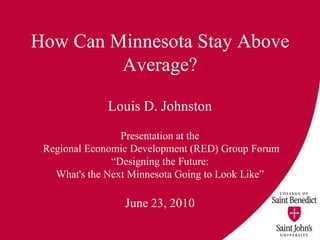
Louis johnston red group talk 06 22-2010
- 1. How Can Minnesota Stay Above Average? Louis D. Johnston Presentation at the Regional Economic Development (RED) Group Forum “Designing the Future: What's the Next Minnesota Going to Look Like” June 23, 2010
- 5. ''Milton's out to save the world and I'm out to understand it.'' George Stigler NY Times, October 21, 1982
- 6. Quick overview: • Economic growth in Minnesota since World War II: The data • Economic theory: The sources of economic growth • Economic policy: what role for policy in promoting and sustaining economic growth?
- 7. Economic growth in Minnesota since World War II: The data
- 9. Income per person: by region, relative to the U.S. average 1.20 1.10 1.00 Relative to U.S. average Minnesota 0.90 0.80 0.70 0.60 Year
- 10. Income per person: by region, relative to the U.S. average 1.20 1.10 Minnesota 1.00 Relative to U.S. average Great 0.90 Lakes 0.80 0.70 0.60 Year
- 11. Income per person: by region, relative to the U.S. average 1.20 1.10 Minnesota 1.00 Relative to U.S. average Great Lakes 0.90 Plains 0.80 0.70 0.60 Year
- 13. Economic theory: Output per person (Per capita income) output per person = participation rate · output per worker
- 14. Economic theory: Growth of per capita income Growth of participation rate Growth of per capita Growth of income output per worker
- 15. Economic theory: Growth of output per worker Growth of Growth of Growth of resources total factor output per per productivity worker worker
- 16. Economic theory: Growth of per capita income Growth of participation rate Growth of Growth of resources per per capita worker income Growth of total factor productivity
- 17. Economic theory: Two types of growth • Catch-up growth • Endogenous growth
- 18. Economic theory: Catch-up growth Total factor productivity is lower than other areas Total factor productivity can be increased by adopting institutions and technologies from leading areas
- 19. Economic theory: Catch-up growth Rapid growth of participation rate Rapid growth Growth of of resources per capita per worker income Adoption and improvement of existing institutions and technologies
- 20. Minnesota, 1950s through 2000s: Catch-up growth • Higher-than-average growth in participation rate - Married women with children - Young people from surrounding states
- 21. Minnesota, 1950s through 2000s: Catch-up growth • Higher-than-average growth in resources per worker Human capital Physical capital
- 22. Minnesota, 1950s through 2000s: Catch-up growth • Increases in human capital Education: grew faster than national average o High school graduation rates rose o Rates of post-secondary education attendance rose
- 23. Minnesota, 1950s through 2000s: Catch-up growth • Increases in human capital Health o Public health (vaccination rates, infant and maternal mortality) o Medical care (including dentistry)
- 24. Minnesota, 1950s through 2000s: Catch-up growth • Increases in physical capital Private capital o Broad and deep local financial markets and institutions o High rates of return attract out-of- state capital investment
- 25. Minnesota, 1950s through 2000s: Catch-up growth • Increases in physical capital Public capital o Transportation (roads, river transport) o Water and sewer systems
- 26. Minnesota, 1950s through 2000s: Catch-up growth • Adoption and improvement of existing technologies Computers Medical devices
- 27. Minnesota, 1950s through 2000s: Catch-up growth • Government effort to make Minnesota “big league” Human rights efforts Public amenities
- 28. Economic theory: Endogenous growth • Total factor productivity growth is driving factor • Endogenous: total factor productivity comes from intentional application of resources towards innovation • Participation and resources per worker grow relatively slowly
- 29. Economic theory: Endogenous growth Total factor productivity is higher than almost all other areas Total factor productivity must be increased by new innovations and improved input quality
- 30. Economic theory: Endogenous growth Slow of growth of participation rate Slow growth of Growth of resources per per capita worker income New innovations and improved input quality
- 31. Minnesota, 2010 onward • Participation rates have stabilized • Quantities of human capital and physical capital are growing more slowly • Innovation has picked up • Medical devices • Retailing
- 32. Minnesota, 2010 onward • Growth depends on increasing total factor productivity through improved quality of inputs, not just quantities
- 33. Minnesota, 2010 onward • Education o Early-childhood education o Improved graduation rates for non- white students o Lifelong learning
- 34. Minnesota, 2010 onward • Health o For young: prevention o For adults: wellness o For older adults: ability to treat illness outside of hospitals and nursing homes
- 35. Minnesota, 2010 onward • Public capital and government o Better transportation, not just more o Improve productivity of water and sewer systems o Government services: competition and community
- 36. How Minnesota Became Above Average 1950s-2000s 2010 onward (Catch-up growth) (Endogenous growth) • Growth in quantity of • Growth in quality of resources resources • Adoption and • Development of new improvement of institutions and existing institutions technologies that and technologies from expand the the technological technological frontier frontier
- 37. The big questions for public policy: Do people follow jobs? or Do jobs follow people?
- 38. How Minnesota Became Above Average 1950s-2000s 2010 onward (People follow jobs) (Jobs follow people) • Public policy focus: • Public policy focus: – Accumulate and attract – Improve quality of more human and human and physical physical capital capital – Technology transfer – Technological innovation
- 39. Thanks for your attention and participation!
- 40. Questions?